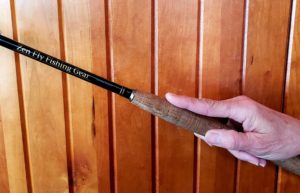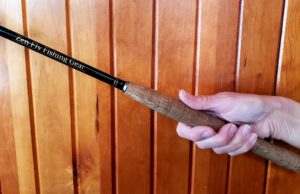Hand a fly rod to most any angler and he or she will hold it in their hand about the same way. They may grip the rod handle slightly higher or lower but generally it will resemble a “handshake” with the thumb up and the rest of the fingers and palm wrapping around the cork. In tenkara, we’re taught to hold our rods differently. Instead, we extend our index finger out along the length of the handle on what could be called the “top” (even though there’s no top or bottom to a tenkara rod), and wrap our thumb and remaining fingers around the handle. What’s the reason for this and is it necessary?
Why is a Tenkara Grip Different?
When we extend our index finger out along the length of the handle (like when you’re pointing), and wrap our thumb and remaining fingers around the handle we create a lighter grip – a softer grip, if you will. This is in part due to where the brunt of the handle pressure is placed on your hand and index finger, and the power that you can transfer to the rod when in that position. Using a tradition tenkara grip, the butt of the handle generally sits in the center of the palm of your hand. The greatest point of pressure is distributed between the rod, your index finger and your palm. You may hold the rod further up the handle while still using a traditional tenkara grip. The points of pressure remains the same and highly involve your index finger. When your hand is in this position it allows you to freely engage your wrist and permits a more precise and delicate movement. Think of pointing or pressing a button.


When we use a handshake grip as in regular fly fishing, with the thumb on top and the rest of the fingers and palm wrapping around the handle, we engage our thumb – a vastly more powerful appendage than the index finger, that both flexes and rotates. With our thumb extended along the length of the rod handle, we have a more powerful grip and can readily engage our shoulder as well. This difference is what sets the two casts apart: index finger and wrist, verses thumb and shoulder. It is difficult and unnatural to bend or move the wrist when in a handshake grip – generally we engage and move the entire arm. Likewise, it is difficult or unnatural to use or engage the shoulder when in a tenkara grip – which generally engages the wrist. Both grips naturally encourage and employ different accompanying joints and muscle movements, thus resulting in different casting strokes.
What Happens If…
Maybe you’re used to holding a fly rod or fishing pole with a handshake grip, what happens if you also use it on a tenkara rod? Well the simple answer is, it may still work but in most instances, not very well and here’s why.
When fishing traditional tenkara with a short, light line, held off the water, the tenkara grip is most effective. The tenkara grip and wrist cast will allow you the most precise and delicate presentation. It also allows you to create slight movements with that extended index finger to manipulate and play with your fly by tapping your index finger on the rod to make small fly movements. Doing this same thing with your thumb would be less effective – sort of like the difference between a mouse and a bull, in a china shop. To describe it more technically, its the difference between a “precision grip” where the force is applied between the fingertip and a small point or target and a “power grip” which demands the entire hand for greater stability and power.
When utilizing a power grip on a traditional tenkara rod and setup, the resulting cast is usually way too much. The excessive power from the grip and the engagement of the shoulder actually overloads the rod and produces less favorable results. The cast is less precise and less delicate. If it doesn’t crumble to the ground, if often bounces backward from too much energy in the line. The more flexible the rod, the less effort or energy required to cast it. Remember, tenkara rods are long levers, similar to a catapult – with the addition of stored energy in the flex, which translates into kinetic energy during the casting stroke and the shooting or throwing of the line and fly. Since tenkara rods are so light, the wrist and index finger can do this with ease – its unnecessary to utilize the power and strength of the thumb and shoulder. Power grips on tenkara rods generally, create too much power. Change things out to a stiffer tenkara rod or attach a longer or heavier line, and precision grips become less effective.
So Do I Switch…
You guessed it – YES! Switching from a “precision/tenkara grip” to a “power/fly rod grip” is often appropriate if you’re casting much longer or heavier lines, and is way more efficient. By definition from
ScienceDirect.com, “Power grips are high force and low precision movements because they use the bulk of the hand for force generation rather than the strength of individual fingers (as in the precision grip). The resulting actions lead to large arm (and shoulder) movements for lifting, moving and picking up larger and heavier objects.” A longer, denser line with more mass can’t effectively be cast with a quick flick of the wrist. It requires more power to move more line. In this scenario, a “power grip” cuts the mustard. If you’re using long or heavier lines, rotate your hand to a thumb-up position and switch your grip. You’ll be happier for doing it.
Conscious Casting
Your science lesson is now complete. Hopefully you now know the difference between a “precision grip” and a “power grip” and understand why most tenkara anglers traditionally use a “tenkara grip” (technically a “precision grip”), to hold and cast their rods. It’s less powerful, more precise and engages your wrist, which pairs well with ultralight, long, flexible, catapult/slingshot/lever tenkara rods. You hopefully also understand why regular fly anglers who cast a stiffer, heavier fly rod with heavier and longer fly lines, need more strength and utilize a “power grip” which engages the whole arm and shoulder to generate greater power and force. Comprehending the science behind it, allows you to make conscious choices about how to hold and cast your rods and gives you a better understanding of the results each grip will produce. Now, you can make a conscious choice to gain the casting results you desire. Wrist or shoulder? Index or thumb? Short line or long line? Precision or power? Consider your surroundings, consider your target, consider your rod and line. Now decide which grip to use.








Karin,
Thx for the explanation on casting grips. Do you recommend the power grip for landing all fish? For example, would the precision grip transfer more sensitivity to the angler when landing a 6 inch Brookie on 6X tippet?
Hi Steve and thanks for the comment and inquiry- Yes! You’ll be more sensitive to feedback that transfers from the fish, through the rod and to your fingertip. Us on a 6 inch Brooke you don’t need as much power to play and respond. And, you don’t want to over reached break that light tippet from overpowering the fish. Power grips are great for casting longer or heavier lines, or managing bigger fish who take bigger runs. You hit the nail on the head!